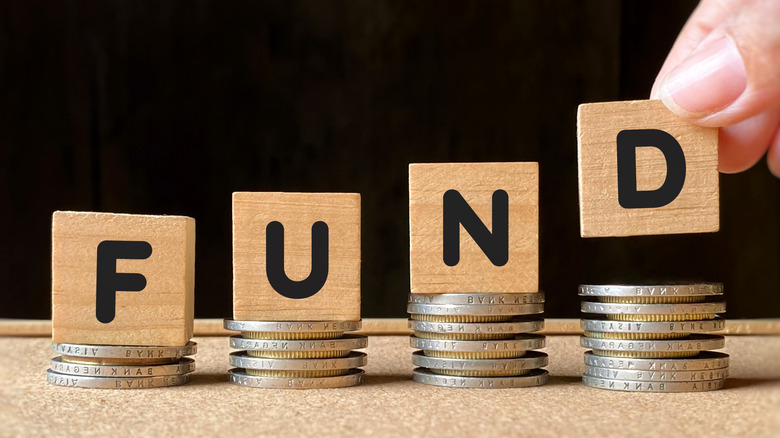When Your Savings Reach This Number, Start Investing In Mutual Funds
After you've saved up $50,000, it's a good time to start putting your money into mutual funds. A mutual fund is a way to invest with other people by placing money into one big pot. That money is then used to buy a mix of stocks, bonds, or both. You don't need a lot to get started; some funds let you initially invest just $500 or even nothing, per Fidelity.
Before you set up the mutual fund, however, build your emergency fund, it's one of the ways retirees can combat the effects of a recession. Try to save enough to cover three to six months of basic expenses like rent, food, electricity, insurance, and loan payments. If your income isn't steady, save even more. Keep this money in a regular savings account at a bank or credit union so it's easy to get when you need it.
Make your emergency fund easy to build by setting a clear plan. First, figure out your total monthly bills, then multiply by how many months you want to cover, then open a separate savings account just for this money. Set up automatic transfers from your paycheck into that account. If you get extra money like a tax refund or cash gift, add some of it to the fund. Every few months, check your expenses. If your bills go up, like your average spend on groceries, increase how much you're saving to keep up.
How a mutual fund works
Mutual funds only set their price once a day, after the stock market closes. Under the SEC's Rule 22c-1, the price you get for buying or selling mutual fund shares depends on when your order is received by the fund or its agent. If your order goes in before the fund's set daily deadline — usually 4PM EST — you get that same day's price, which is calculated after the market closes. If it comes in after that time, you get the next business day's price instead.
One cost to watch is the fund's yearly fee, shown as a small percentage. For example, if you invest $50,000 in a fund with a 0.50% fee, you'll pay $250 per year. That may seem small, but over time, higher fees can cut into your returns.
When a mutual fund makes money from stock dividends or bond interest, it collects and pays it out to investors on a regular schedule. Most stock index funds do this every three months. For example, the Vanguard 500 Index Admiral (VFIAX) pays out four times a year. In 2025, it tracked who owned shares on March 26, June 27, September 26, and December 19. The next day, March 27, June 30, September 29, and December 22, was when shares stopped earning for that quarter, and reinvestment kicked in. The actual payments, either in cash or extra shares, were delivered on March 28, July 1, September 30, and December 23.
Mutual funds you can opt for
If you want a fund that adjusts itself as you get closer to retirement, look at target-date mutual funds. For example, the Vanguard Target Retirement 2055 Fund (VFFVX) charges about $8 a year for every $10,000 invested, the Fidelity Freedom Index 2055 Fund (FDEWX) takes about $12 per $10,000, and the Schwab Target 2055 Index Fund (SWYJX) charges $8 with a discount, or $14 without it. Each one begins heavy on stocks to help your money grow, and slowly shifts into safer options like bonds as 2055 gets closer.
If you want a simple setup you can manage yourself, you can put money into one stock fund and one bond fund from the same company. Vanguard offers VTSAX for stocks and VBTLX for bonds, and each fund charges about $4 a year for every $10,000 you invest. Fidelity's FSKAX (stock) and FXNAX (bond) cost around $1.50 and $2.50 per $10,000. Schwab's options are SWTSX for stocks and SWAGX for bonds, with annual costs of about $3 and $4 per $10,000.
If you want one fund that gives you both income and growth without much upkeep, look at balanced funds that keep a steady mix of stocks and bonds. Vanguard Balanced Index Admiral (VBIAX) includes about 60% stocks and 40% bonds, and charges around $7 per year for every $10,000 you invest. Vanguard Wellington Admiral (VWENX) leans slightly more into stocks at about 65/35 and costs about $17 per $10,000.


